Use of Low-Cost Sensors to Characterize Occupational Exposure to PM2.5 Concentrations Inside an Industrial Facility in Santa Ana, CA: Results from a Worker- and Community-Led Pilot Study
Abstract
:1. Introduction
2. Materials and Methods
2.1. Indoor Monitoring
2.2. Outdoor Monitoring
3. Results
3.1. Indoor Monitoring
3.2. Outdoor Monitoring
4. Discussion
4.1. Indoor Monitoring
4.2. Outdoor Monitoring
4.3. Improving Workplace Health
5. Conclusions
Supplementary Materials
Author Contributions
Funding
Institutional Review Board Statement
Informed Consent Statement
Data Availability Statement
Acknowledgments
Conflicts of Interest
References
- Reid, C.E.; Brauer, M.; Johnston, F.H.; Jerrett, M.; Balmes, J.R.; Elliott, C.T. Critical review of health impacts of wildfire smoke exposure. Environ. Health Perspect. 2016, 124, 1334–1343. [Google Scholar] [CrossRef] [PubMed] [Green Version]
- Wu, J.; Winer, A.; Delfino, R. Exposure assessment of particulate matter air pollution before, during, and after the 2003 Southern California wildfires. Atmos. Environ. 2006, 40, 3333–3348. [Google Scholar] [CrossRef] [Green Version]
- Vedal, S.; Dutton, S.J. Wildfire air pollution and daily mortality in a large urban area. Environ. Res. 2006, 102, 29–35. [Google Scholar] [CrossRef]
- Dockery, D.W.; Pope, C.A., III; Xu, X.; Spengler, J.D.; Ware, J.H.; Fay, M.E.; Ferris, B.G., Jr.; Speizer, F.E. An association between air pollution and mortality in six U.S. cities. N. Engl. J. Med. 1993, 329, 1753–1759. [Google Scholar] [CrossRef] [PubMed] [Green Version]
- Chow, J.C.; Watson, J.G.; Mauderly, J.L.; Costa, D.L.; Wyzga, R.E.; Vedal, S.; Hidy, G.M.; Altshuler, S.L.; Marrack, D.; Heuss, J.M.; et al. Health effects of fine particulate air pollution: Lines that connect. J. Air Waste Manag. Assoc. 2006, 56, 1368–1380. [Google Scholar] [CrossRef] [PubMed]
- Kloog, I.; Coull, B.A.; Zanobetti, A.; Koutrakis, P.; Schwartz, J.D. Acute and chronic effects of particles on hospital admissions in New-England. PLoS ONE 2012, 7, e34664. [Google Scholar] [CrossRef] [PubMed] [Green Version]
- Bu, X.; Xie, Z.; Liu, J.; Wei, L.; Wang, X.; Chen, M.; Ren, H. Global PM2.5-attributable health burden from 1990 to 2017: Estimates from the Global Burden of disease study 2017. Environ. Res. 2021, 197, 111123. [Google Scholar] [CrossRef] [PubMed]
- Flies, E.J.; Mavoa, S.; Zosky, G.R.; Mantzioris, E.; Williams, C.; Eri, R.; Brook, B.W.; Buettel, J.C. Urban-associated diseases: Candidate diseases, environmental risk factors, and a path forward. Environ. Int. 2019, 133, 105187. [Google Scholar] [CrossRef]
- WHO Air Quality Gudelines. In WHO Global Air Quality Guidelines: Particulate Matter (PM2.5 and PM10), Ozone, Nitrogen Dioxide, Sulfur Dioxide and Carbon Monoxide; World Health Organization: Geneva, Switzerland, 2021.
- Yang, X.; Zhang, T.; Zhang, Y.; Chen, H.; Sang, S. Global burden of COPD attributable to ambient PM2.5 in 204 countries and territories, 1990 to 2019: A systematic analysis for the Global Burden of Disease Study 2019. Sci. Total Environ. 2021, 796, 148819. [Google Scholar] [CrossRef]
- Verbeek, T. Unequal residential exposure to air pollution and noise: A geospatial environmental justice analysis for Ghent, Belgium. SSM Popul. Health 2019, 7, 100340. [Google Scholar] [CrossRef]
- Li, V.O.; Han, Y.; Lam, J.C.; Zhu, Y.; Bacon-Shone, J. Air pollution and environmental injustice: Are the socially deprived exposed to more PM2.5 pollution in Hong Kong? Environ. Sci. Policy 2018, 80, 53–61. [Google Scholar] [CrossRef]
- Mikati, I.; Benson, A.F.; Luben, T.J.; Sacks, J.D.; Richmond-Bryant, J. Disparities in distribution of particulate matter emission sources by race and poverty status. Am. J. Public Health 2018, 108, 480–485. [Google Scholar] [CrossRef] [PubMed]
- Morello-Frosch, R.; Pastor, M.; Porras, C.; Sadd, J. Environmental justice and regional inequality in Southern California: Implications for furture research. Environ. Health Perspect. 2002, 110, 149–154. [Google Scholar] [CrossRef] [PubMed] [Green Version]
- Chakraborty, J.; Zandbergen, P.A. Children at risk: Measuring racial/ethnic disparities in potential exposure to air pollution at school and home. J. Epidemiol. Community Health 2007, 61, 1074–1079. [Google Scholar] [CrossRef] [PubMed] [Green Version]
- Gaffron, P.; Niemeier, D. School locations and traffic Emissions—Environmental (In)justice findings using a new screening method. Int. J. Environ. Res. Public Health 2015, 12, 2009–2025. [Google Scholar] [CrossRef] [Green Version]
- Mirabelli, M.C.; Wing, S.; Marshall, S.W.; Wilcosky, T.C. Race, poverty, and potential exposure of middle-school students to air emissions from confined swine feeding operations. Environ. Health Perspect. 2006, 114, 591–596. [Google Scholar] [CrossRef] [Green Version]
- Pastor, M.; Sadd, J.L.; Morello-Frosch, R. Who’s minding the kids? Pollution, public schools, and environmental justice in Los Angeles. Soc. Sci. Q. 2002, 83, 263–280. [Google Scholar] [CrossRef]
- United Church of Christ Commission for Racial Justice. Toxic Waste and Race in he United States: A National Report on the Racial and Socio-Economic Characteristics of Communities with Hazardous Waste Sites; Commission for Racial Justice: New York, NY, USA, 1987.
- Collins, T.W.; Grineski, S.E.; Nadybal, S.M. A Comparative Approach for Environmental Justice Analysis: Explaining Divergent Societal Distributions of Particulate Matter and Ozone Pollution across U.S. Neighborhoods. Ann. Am. Assoc. Geogr. 2022, 112, 522–541. [Google Scholar] [CrossRef]
- Woo, B.; Kravitz-Wirtz, N.; Sass, V.; Crowder, K.; Teixeira, S.; Takeuchi, D.T. Residential Segregation and Racial/Ethnic Disparities in Ambient Air Pollution. Race Soc. Probl. 2019, 11, 60–67. [Google Scholar] [CrossRef]
- Tessum, C.W.; Paolella, D.A.; Chambliss, S.E.; Apte, J.S.; Hill, J.D.; Marshall, J.D. PM2.5 polluters disproportionately and systemically affect people of color in the United States. Sci. Adv. 2021, 7, 1–7. [Google Scholar] [CrossRef]
- Rosofsky, A.; Levy, J.I.; Zanobetti, A.; Janulewicz, P.; Fabian, M.P. Temporal trends in air pollution exposure inequality in Massachusetts. Environ. Res. 2018, 161, 76–86. [Google Scholar] [CrossRef] [PubMed]
- Khajeamiri, Y.; Sharifi, S.; Moradpour, N.; Khajeamiri, A. A review on the effect of air pollution and exposure to PM, NO2, O3, SO2, CO and heavy metals on viral respiratory infections. J. Air Pollut. Health 2021, 5, 243–258. [Google Scholar] [CrossRef]
- Blumberg, A.H.; Ebelt, S.T.; Liang, D.; Morris, C.R.; Sarnat, J.A. Ambient air pollution and sickle cell disease-related emergency department visits in Atlanta, GA. Environ. Res. 2020, 184, 109292. [Google Scholar] [CrossRef] [PubMed]
- Zu, D.; Zhai, K.; Qiu, Y.; Pei, P.; Zhu, X.; Han, D. The impacts of air pollution on mental health: Evidence from the chinese university students. Int. J. Environ. Res. Public Health 2020, 17, 6734. [Google Scholar] [CrossRef] [PubMed]
- Zhu, Y.; Xie, J.; Huang, F.; Cao, L. Association between short-term exposure to air pollution and COVID-19 infection: Evidence from China. Sci. Total Environ. 2020, 727, 138704. [Google Scholar] [CrossRef] [PubMed]
- Milicevic, O.; Salom, I.; Rodic, A.; Markovic, S.; Tumbas, M.; Zigic, D.; Djordjevic, M.; Djordjevic, M. PM2.5 as a major predictor of COVID-19 basic reproduction number in the USA. Environ. Res. 2021, 201, 111526. [Google Scholar] [CrossRef]
- Liang, D.; Shi, L.; Zhao, J.; Liu, P.; Sarnat, J.A.; Gao, S.; Schwartz, J.; Liu, Y.; Ebelt, S.T.; Scovronick, N.; et al. Urban Air Pollution May Enhance COVID-19 Case-Fatality and Mortality Rates in the United States. Innovation 2020, 1, 100047. [Google Scholar] [CrossRef]
- Hendryx, M.; Luo, J. COVID-19 prevalence and fatality rates in association with air pollution emission concentrations and emission sources. Environ. Pollut. 2020, 265, 115126. [Google Scholar] [CrossRef]
- Páez-Osuna, F.; Valencia-Castañeda, G.; Rebolledo, U.A. The link between COVID-19 mortality and PM2.5 emissions in rural and medium-size municipalities considering population density, dust events, and wind speed. Chemosphere 2022, 286, 131634. [Google Scholar] [CrossRef]
- Copat, C.; Cristaldi, A.; Fiore, M.; Grasso, A.; Zuccarello, P.; Signorelli, S.S.; Conti, G.O.; Ferrante, M. The role of air pollution (PM and NO2) in COVID-19 spread and lethality: A systematic review. Environ. Res. 2020, 191, 110129. [Google Scholar] [CrossRef]
- English, P.B.; Richardson, M.J.; Garzón-Galvis, C. From Crowdsourcing to Extreme Citizen Science: Participatory Research for Environmental Health. Annu. Rev. Public Health 2018, 39, 335–350. [Google Scholar] [CrossRef] [PubMed] [Green Version]
- Zagozewski, R.; Judd-Henrey, I.; Nilson, S.; Bharadwaj, L. Perspectives on past and Present Waste Disposal Practices: A community-Based Participatory Research Project in Three Saskatchewan First Nations Communities. Environ. Health Insights 2011, 5, 9–20. [Google Scholar] [CrossRef] [PubMed] [Green Version]
- Gonzalez, P.A.; Minkler, M.; Garcia, A.P.; Gordon, M.; Garzón, C.; Palaniappan, M.; Prakash, S.; Beveridge, B. Community-based participatory research and policy advocacy to reduce diesel exposure in West Oakland, California. Am. J. Public Health 2011, 101, 166–175. [Google Scholar] [CrossRef] [PubMed]
- Garcia, A.P.; Minkler, M.; Cardenas, Z.; Grills, C.; Porter, C. Engaging Homeless Youth in Community-Based Participatory Research: A Case Study From Skid Row, Los Angeles. Health Promot. Pract. 2014, 15, 18–27. [Google Scholar] [CrossRef]
- Masri, S.; LeBrón, A.; Logue, M.; Valencia, E.; Ruiz, A.; Reyes, A.; Lawrence, J.M.; Wu, J. Social and spatial distribution of soil lead concentrations in the City of Santa Ana, California: Implications for health inequities. Sci. Total Environ. 2020, 743, 1–11. [Google Scholar] [CrossRef]
- Perelló, J.; Cigarini, A.; Vicens, J.; Bonhoure, I.; Rojas-Rueda, D.; Nieuwenhuijsen, M.J.; Cirach, M.; Daher, C.; Targa, J.; Ripoll, A. Large-scale citizen science provides high-resolution nitrogen dioxide values and health impact while enhancing community knowledge and collective action. Sci. Total Environ. 2021, 789, 147750. [Google Scholar] [CrossRef]
- Varaden, D.; Leidland, E.; Lim, S.; Barratt, B. “I am an air quality scientist”—Using citizen science to characterise school children’s exposure to air pollution. Environ. Res. 2021, 201, 111536. [Google Scholar] [CrossRef]
- Webb, L.; Sleeth, D.K.; Handy, R.; Stenberg, J.; Schaefer, C.; Collingwood, S.C. Indoor Air Quality Issues for Rocky Mountain West Tribes. Front. Public Health 2021, 9, 1–7. [Google Scholar] [CrossRef]
- Johnston, J.E.; Juarez, Z.; Navarro, S.; Hernandez, A.; Gutschow, W. Youth engaged participatory air monitoring: A ‘day in the life’ in urban environmental justice communities. Int. J. Environ. Res. Public Health 2020, 17, 93. [Google Scholar] [CrossRef] [Green Version]
- Bi, J.; Stowell, J.; Seto, E.Y.W.; English, P.B.; Al-Hamdan, M.Z.; Kinney, P.L.; Freedman, F.R.; Liu, Y. Contribution of low-cost sensor measurements to the prediction of PM2.5levels, A case study in Imperial County, California, USA. Environ. Res. 2020, 180, 108810. [Google Scholar] [CrossRef]
- Morawska, L.; Thai, P.K.; Liu, X.; Asumadu-Sakyi, A.; Ayoko, G.; Bartonova, A.; Bedini, A.; Chai, F.; Christensen, B.; Dunbabin, M.; et al. Applications of low-cost sensing technologies for air quality monitoring and exposure assessment: How far have they gone? Environ. Int. 2018, 116, 286–299. [Google Scholar] [CrossRef] [PubMed]
- Pope, F.D.; Gatari, M.; Ng’ang’a, D.; Poynter, A.; Blake, R. Airborne particulate matter monitoring in Kenya using calibrated low-cost sensors. Atmos. Chem. Phys. 2018, 18, 15403–15418. [Google Scholar] [CrossRef] [Green Version]
- Larkin, A.; Hystad, P. Towards Personal Exposures: How Technology Is Changing Air Pollution and Health Research. Curr. Environ. Health Rep. 2017, 4, 463–471. [Google Scholar] [CrossRef] [PubMed]
- Holm, S.M.; Miller, M.D.; Balmes, J.R. Health effects of wildfire smoke in children and public health tools: A narrative review. J. Expo. Sci. Environ. Epidemiol. 2021, 31, 1–20. [Google Scholar] [CrossRef]
- Bi, J.; Wildani, A.; Chang, H.H.; Liu, Y. Incorporating Low-Cost Sensor Measurements into High-Resolution PM2.5 Modeling at a Large Spatial Scale. Environ. Sci. Technol. 2020, 54, 2152–2162. [Google Scholar] [CrossRef]
- Delp, W.W.; Singer, B.C. Wildfire Smoke Adjustment Factors for Low-Cost and Professional PM2.5 Monitors with Optical Sensors. Sensors 2020, 20, 3683. [Google Scholar] [CrossRef]
- Masri, S.; Cox, K.; Flores, L.; Rea, J.; Wu, J. Community-Engaged Use of Low-Cost Sensors to Assess the Spatial Distribution of PM2.5 Concentrations across Disadvantaged Communities: Results from a Pilot Study in Santa Ana, CA. Atmosphere 2022, 13, 304. [Google Scholar] [CrossRef]
- Kingspan Kingspan Group, PLC. Available online: https://www.kingspan.com/group/ (accessed on 15 March 2022).
- South Coast Air Quailty Management District (SCAQMD): Air Quality Sensor Performance Evaluation Center. Field Evaluation Atmotube Pro; SCAQMD: Diamond Bar, CA, USA, 2020.
- South Coast Air Quailty Management District (SCAQMD). Field Evaluation of AtmoTube Pro VOC Sensor; SCAQMD: Diamond Bar, CA, USA, 2021.
- AtmoTube How does Atmotube PM Sensor Work? Available online: https://help.atmotube.com/technical/3-atmotube-pm/ (accessed on 15 March 2022).
- Cornell Law School Legal Information Institute. Available online: https://www.law.cornell.edu/cfr/text/40/appendix-G_to_part_58#fn4_tbl3 (accessed on 10 December 2021).
- Aguilera, R.; Gershunov, A.; Ilango, S.D.; Morales, J.G. Santa Ana Winds of Southern California Impact PM2.5 with and Without Smoke from Wildfires. GeoHealth 2019, 4, 1–9. [Google Scholar] [CrossRef] [Green Version]
- Cleland, S.E.; West, J.J.; Jia, Y.; Reid, S.; Raffuse, S.; O Neill, S.; Serre, M.L. Estimating Wildfire Smoke Concentrations during the October 2017 California Fires through BME Space/Time Data Fusion of Observed, Modeled, and Satellite-Derived PM2.5. Environ. Sci. Technol. 2020, 54, 13439–13447. [Google Scholar] [CrossRef]
- Cal/OSHA. §5141.1 Protection from Wildfire Smoke; Cal/OSHA: Oakland, CA, USA, 2021.
- South Coast Air Quailty Management District (SCAQMD). 2019 Air Quality; SCAQMD: Diamond Bar, CA, USA, 2019.
- U.S. Occupational Safety and Health Administration Particulates Not Otherwise Regulated, Total and Respirable Dust. Available online: https://www.osha.gov/chemicaldata/801 (accessed on 15 March 2022).
- Kim, J.Y.; Chen, J.-C.; Boyce, P.D.; Christiani, D.C. Exposure to welding fumes is associated with acute systemicinflammatory responses. Occup. Environ. Med. 2005, 62, 157–163. [Google Scholar] [CrossRef]
- Hartmann, L.; Bauer, M.; Bertram, J.; Gube, M.; Lenz, K.; Reisgen, U.; Schettgen, T.; Kraus, T.; Brand, P. Assessment of the biological effects of welding fumes emitted from inert gas welding processes of aluminium and zinc-plated materials in humans. Int. J. Hyg. Environ. Health 2014, 217, 160–168. [Google Scholar] [CrossRef] [PubMed]
- Antonini, J.M.; Stone, S.; Roberts, J.R.; Chen, B.; Schwegler-Berry, D.; Afshari, A.A.; Frazer, D.G. Effect of short-term stainless steel welding fume inhalation exposure onlung inflammation, injury, and defense responses in rats. Toxicol. Appl. Pharmacol. 2007, 223, 234–245. [Google Scholar] [CrossRef] [PubMed]
- Antonini, J.M. Health effects of welding. Crit. Rev. Toxicol. 2003, 33, 61–103. [Google Scholar] [CrossRef] [PubMed]
- Wong, J.Y.Y.; De Vivo, I.; Lin, X.; Christiani, D.C. Cumulative PM2.5 exposure and telomere length in workers exposed to welding fumes. J. Toxicol. Environ. Heal. Part A Curr. Issues 2014, 77, 441–455. [Google Scholar] [CrossRef] [Green Version]
- Haluza, D.; Moshammer, H.; Hochgatterer, K. Dust is in the air. Part II: Effects of occupational exposure to welding fumes on lung function in a 9-year study. Lung 2014, 192, 111–117. [Google Scholar] [CrossRef]
- Cal/OSHA. §3395. Heat Illness Prevention in Outdoor Places of Employment; Cal/OSHA: Oakland, CA, USA, 2005.
- U.S. Occupational Safety and Health Administration Heat. Available online: https://www.osha.gov/heat-exposure (accessed on 15 March 2022).
- PurpleAir Inc. PurpleAir. Available online: https://www2.purpleair.com/ (accessed on 10 December 2021).
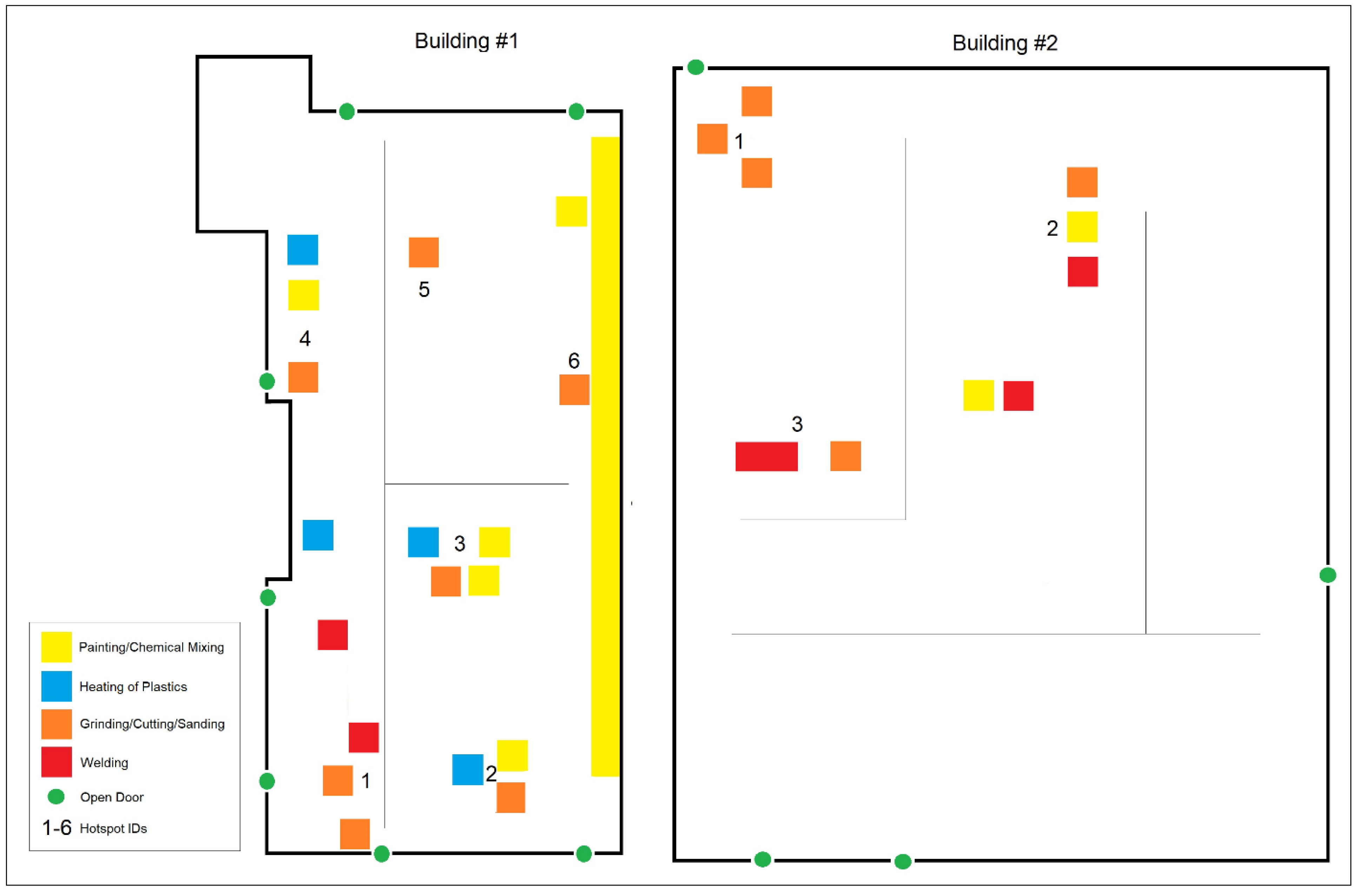
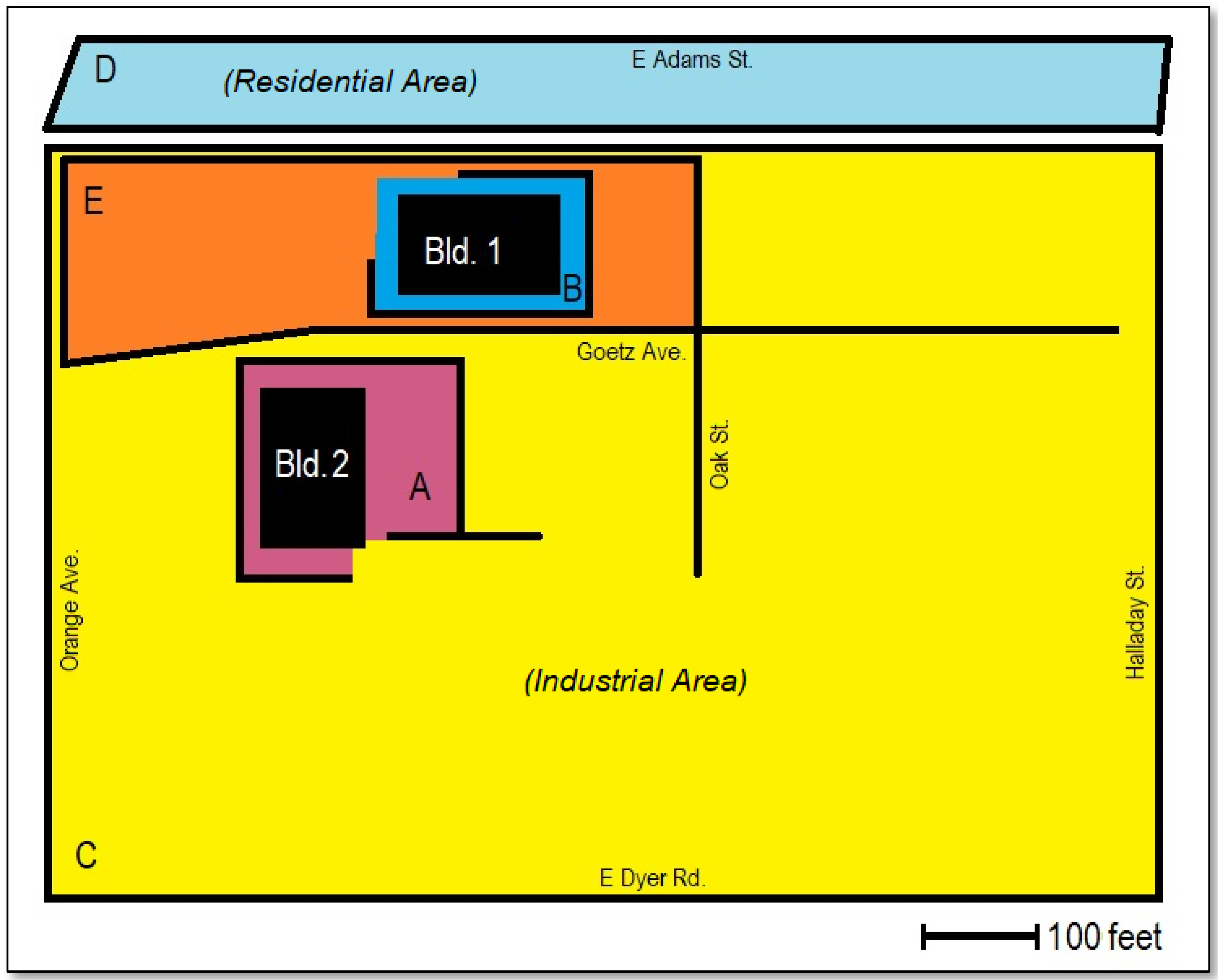
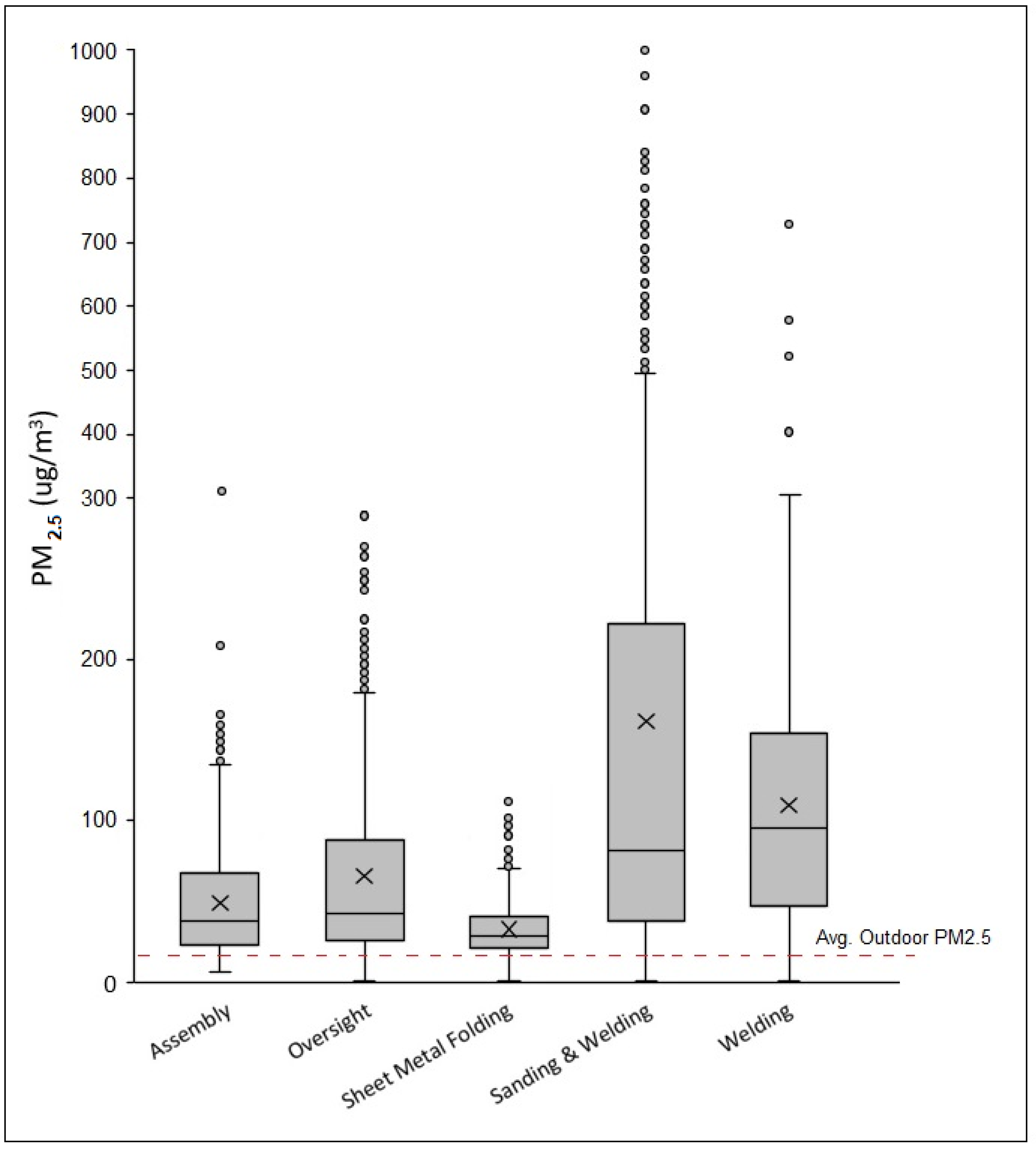
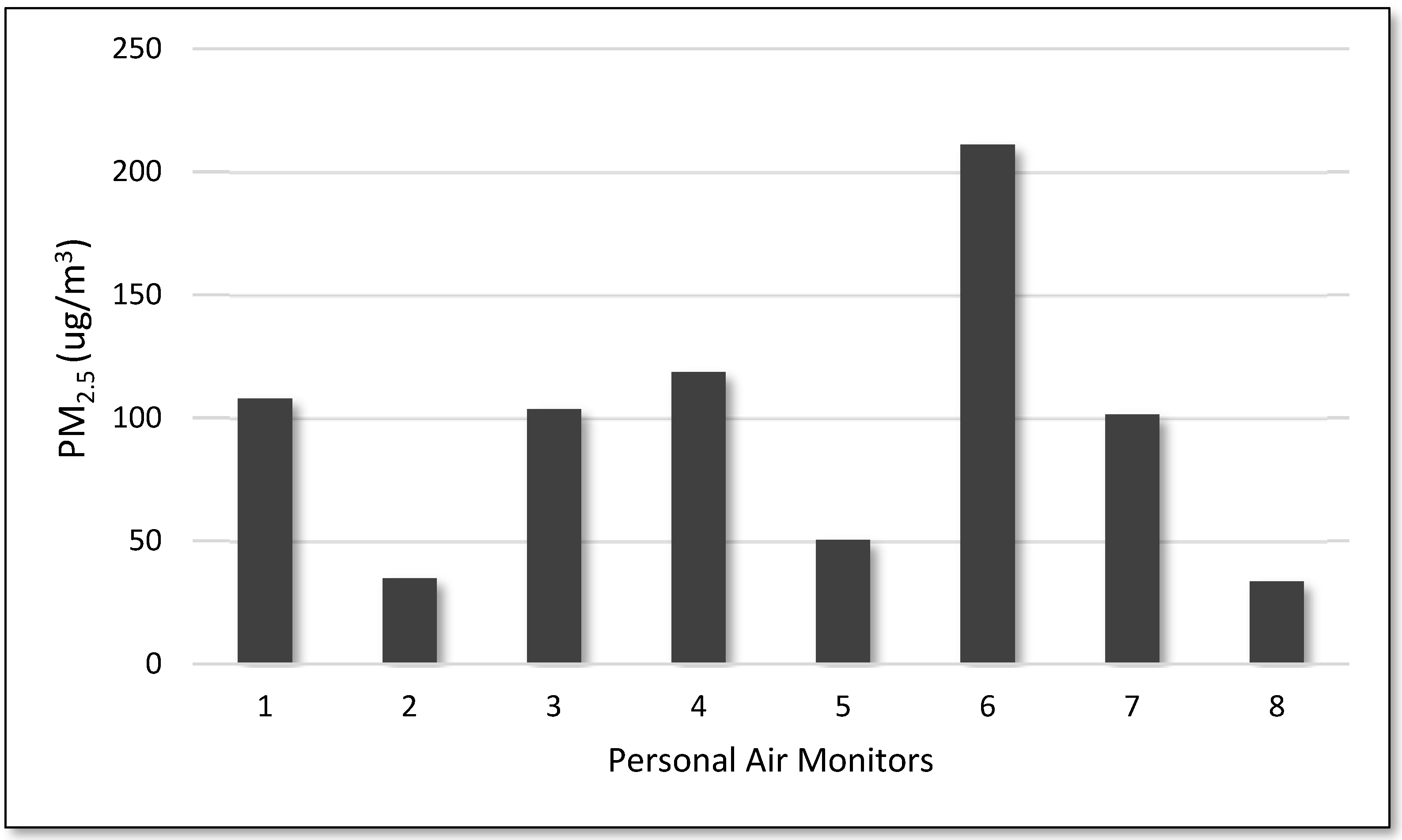
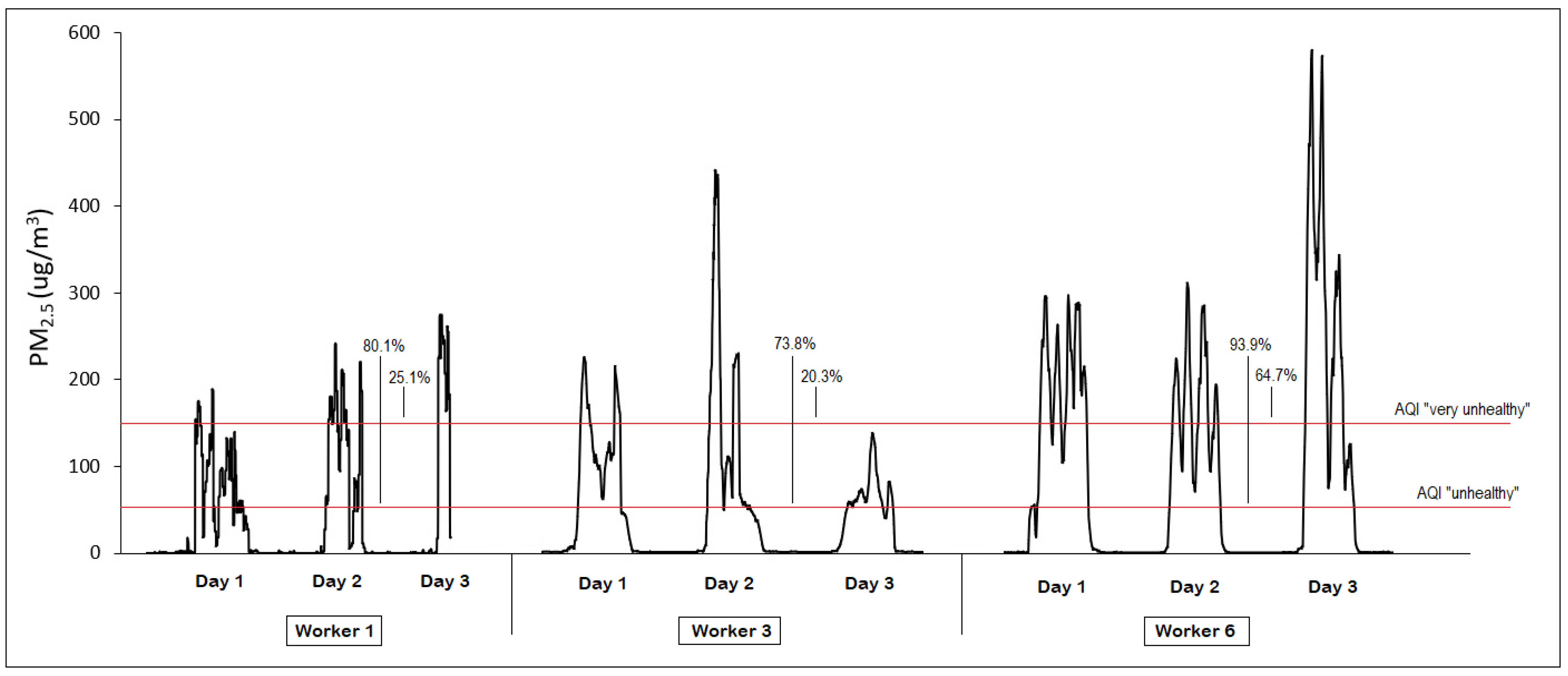
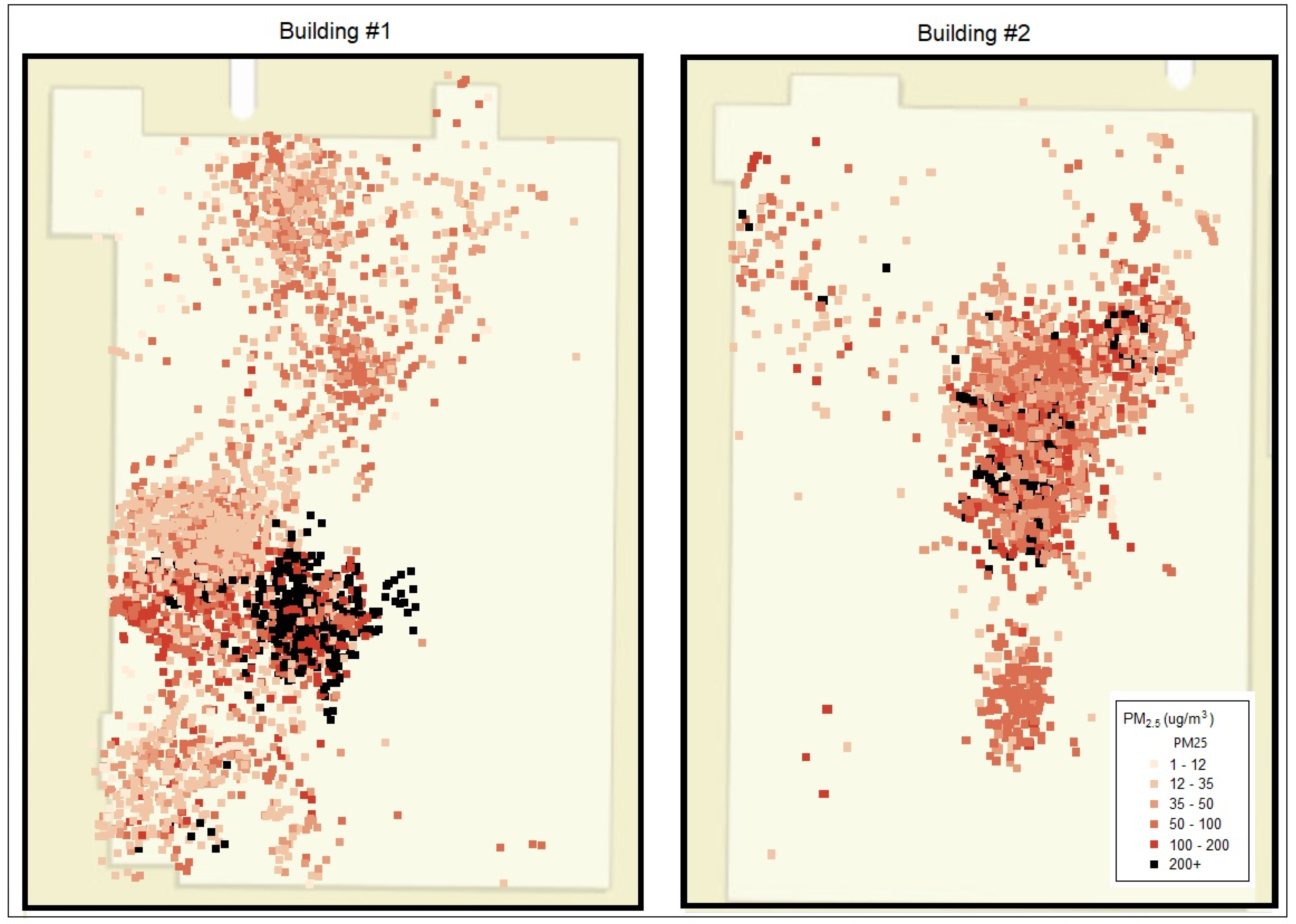
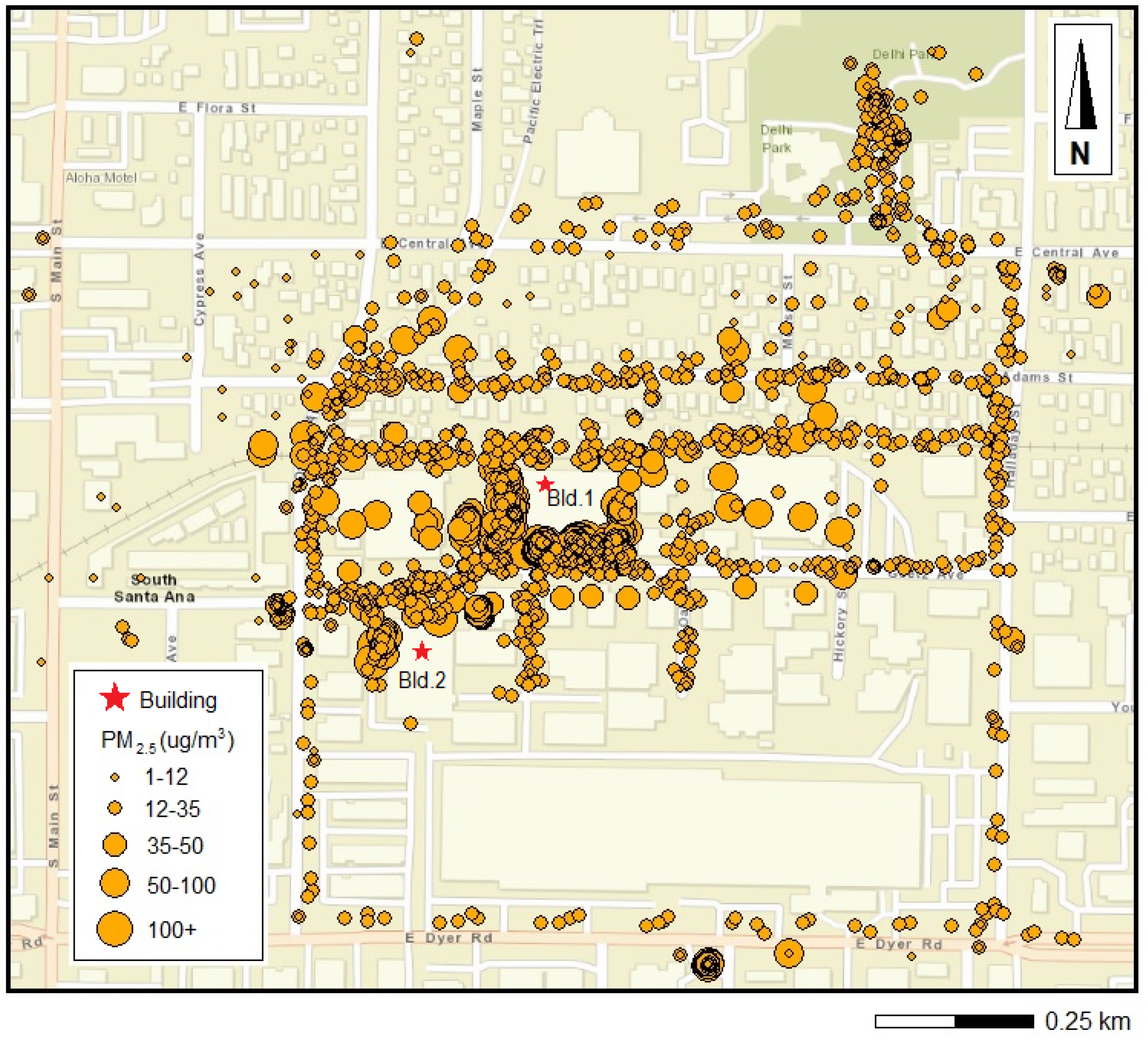
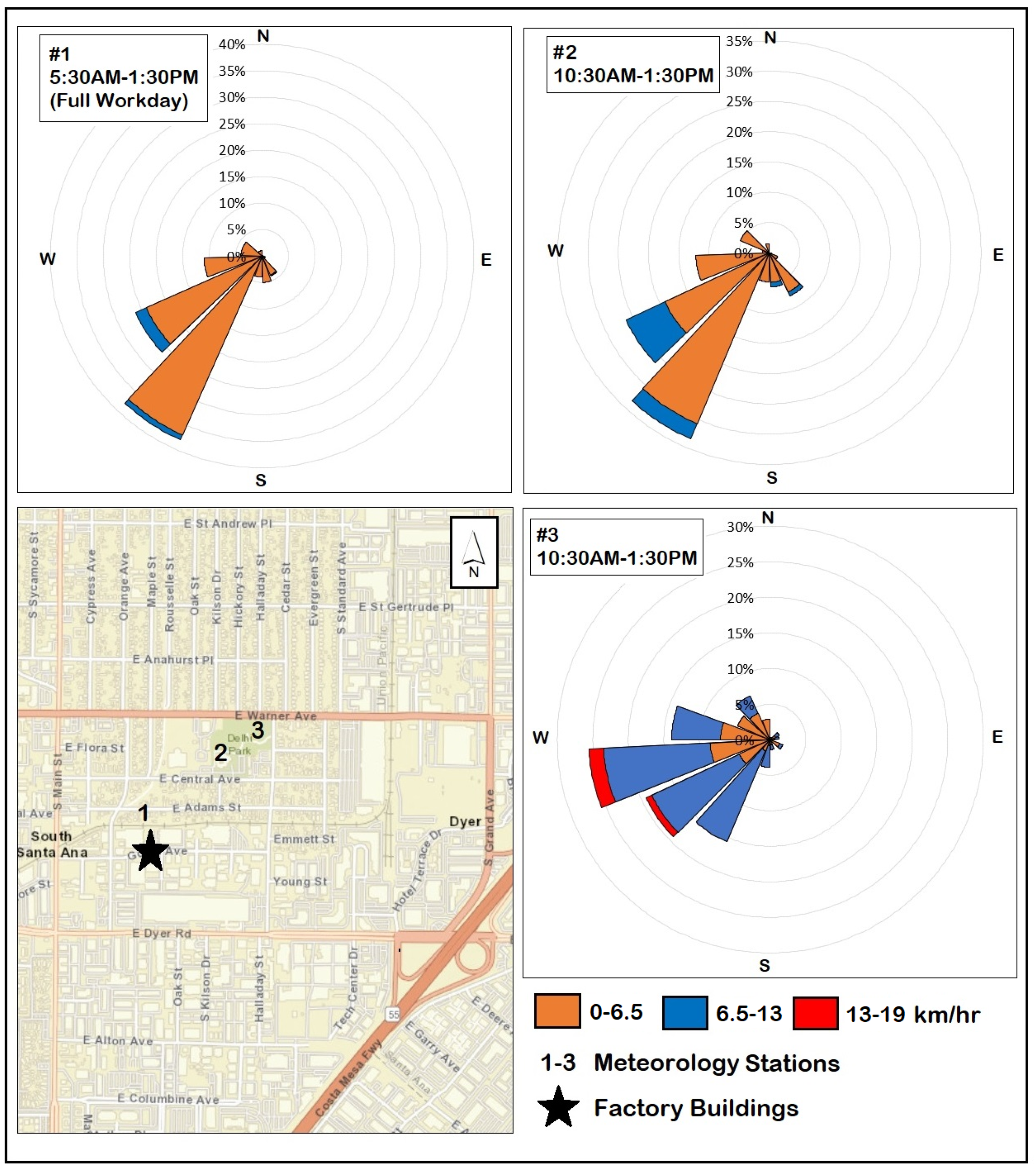
| N a | Mean | St. Dev. | Medan | Min. | Max. | |
|---|---|---|---|---|---|---|
| Indoors by Type | ||||||
| Mobile (Personal) | 10,154 | 91.4 | 118.2 | 51.3 | 1.0 | 1000.0 |
| Stationary | 10,595 | 132.3 | 188.4 | 67.2 | 1.0 | 1000.0 |
| Indoors by Building | ||||||
| Building 1 | 11,562 | 120.3 | 187.9 | 105.2 | 1.0 | 1000.0 |
| Building 2 | 9187 | 102.2 | 112.8 | 73.4 | 1.0 | 1000.0 |
| Outdoors | 867 | 17.3 | 5.3 | 17.4 | 1.0 | 39.0 |
Publisher’s Note: MDPI stays neutral with regard to jurisdictional claims in published maps and institutional affiliations. |
© 2022 by the authors. Licensee MDPI, Basel, Switzerland. This article is an open access article distributed under the terms and conditions of the Creative Commons Attribution (CC BY) license (https://creativecommons.org/licenses/by/4.0/).
Share and Cite
Masri, S.; Rea, J.; Wu, J. Use of Low-Cost Sensors to Characterize Occupational Exposure to PM2.5 Concentrations Inside an Industrial Facility in Santa Ana, CA: Results from a Worker- and Community-Led Pilot Study. Atmosphere 2022, 13, 722. https://doi.org/10.3390/atmos13050722
Masri S, Rea J, Wu J. Use of Low-Cost Sensors to Characterize Occupational Exposure to PM2.5 Concentrations Inside an Industrial Facility in Santa Ana, CA: Results from a Worker- and Community-Led Pilot Study. Atmosphere. 2022; 13(5):722. https://doi.org/10.3390/atmos13050722
Chicago/Turabian StyleMasri, Shahir, Jose Rea, and Jun Wu. 2022. "Use of Low-Cost Sensors to Characterize Occupational Exposure to PM2.5 Concentrations Inside an Industrial Facility in Santa Ana, CA: Results from a Worker- and Community-Led Pilot Study" Atmosphere 13, no. 5: 722. https://doi.org/10.3390/atmos13050722
APA StyleMasri, S., Rea, J., & Wu, J. (2022). Use of Low-Cost Sensors to Characterize Occupational Exposure to PM2.5 Concentrations Inside an Industrial Facility in Santa Ana, CA: Results from a Worker- and Community-Led Pilot Study. Atmosphere, 13(5), 722. https://doi.org/10.3390/atmos13050722







